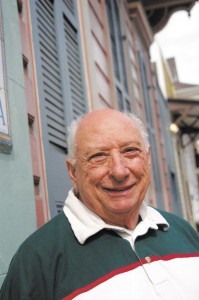Creator of the ‘Cosimo sound’ dies
22nd September 2014 · 0 Comments
By Geraldine Wyckoff
Contributing Writer
As the engineer at his J&M Recording Studio, Cosimo Matassa is rightly credited for being at the center of creating the “New Orleans sound” or the “Cosimo sound.” From the late 1940s to the early 1960s his success brought attention to this city’s wealth of rhythm and blues musicians plus drew national artists like Little Richard and Ray Charles to the city seeking the benefit of his magic.
With Matassa behind the sound board at the small, backroom studio on North Rampart Street, he was at the controls at the dawn of rock ‘n roll, recording such classics as Fats Domino’s first hit, 1949’s “The Fat Man” and Roy Brown’s 1947 “Good Rockin’ Tonight.” Matassa, a modest man, always negated his importance, praising the talented artists for the music’s uniqueness. A Rock n’ Roll Hall of Fame inductee and Lifetime Achievement Grammy winner who many just called Cos, Matassa loved the music, the musicians, his wife of 65 years, Jennie, his family, his Italian heritage and a good – or bad – joke. Cosimo Matassa, a much-loved and respected man, died on September 11, 2014 at the age of 88.
“There really isn’t such a thing,” Matassa once said of the concept of the Cosimo sound. “I’d go into the studio and listen and go into the control room and try to make the music sound like what I heard. My job was to be transparent.”
“I think what made him tick greatly as a man was that he was super intelligent and he dearly loved the music itself,” says pianist/composer/producer Allen Toussaint who first went into the J&M studio when he was 15 years old.
Legendary producer Dave Bartholomew, a lifelong friend of Matassa who was in the studio for a myriad of Fats Domino’s hits and more, appreciated Cosimo not only for his ear for engineering but for his demeanor that helped to make the magic happen. “He’d find something to make you laugh if you were sad,” Bartholomew says. “Anything he could do in this world to make you happy, Mr. Matassa was always there for you. He was such a great person and he treated everybody like a human being. He and his family have always been there for me and the world.”
Being a recording engineer wasn’t really in the stars as a career for Matassa. “I sort of backed into the record business,” Matassa explained. In retrospect that seems like an amazing statement from someone who oversaw some 250 recordings including 21 gold records from a who’s who of greats like Ernie K-Doe, Irma Thomas, Lee Dorsey, Earl King, Professor Longhair, Frankie Ford and many, many more. He explained that his career in music didn’t stem from any particular passion as, like most people residing in the French Quarter at the time, music was simply a part of life.
Matassa had been studying chemistry at Tulane University and in 1944, expecting to be drafted, he wanted some time to goof off and so he dropped out of school “By that time I found out what a chemist really was and realized I didn’t want to be a chemist,” remembered Matassa. When the war in Europe ended and he hadn’t been called into service, his father laid down the law – either go back to school or go to work. He bought out his father’s interest in J&M Music Services, which supplied jukeboxes to stores and bars, and became co-owner with Joseph Mancuso. They took over the store next to J&M’s North Rampart Street offices and set up shop as a new and used records and small appliance store.
“Cosimo rose to the occasion with whatever was needed,” Toussaint remembers.
Matassa’s studios welcomed Black and white musicians, a rarity in the era and frowned upon by some and considered illegal by others. His openness could easily be attributed to his early surrounding environment.
“When I was in the French Quarter, it was much more Black than it is now,” Matassa once said. “In fact Black and white people lived cheek by jowl up and down the street. We were integrated, only we didn’t know it.”
“I forgot to think about race when it comes to Cos,” Toussaint says. “It never crossed our minds – it never, never came up. Race and Cos don’t seem to be in the same universe.”
“Cos had a way of doing things that was unlike other people,” says Dr. John.
“He might have been the easiest going guy we ever knew. He was one of a kind and a half and a real character from his heart.”
“He reached the whole world, and we reached the world through him,” Toussaint says in praise.
This article originally published in the September 22, 2014 print edition of The Louisiana Weekly newspaper.




